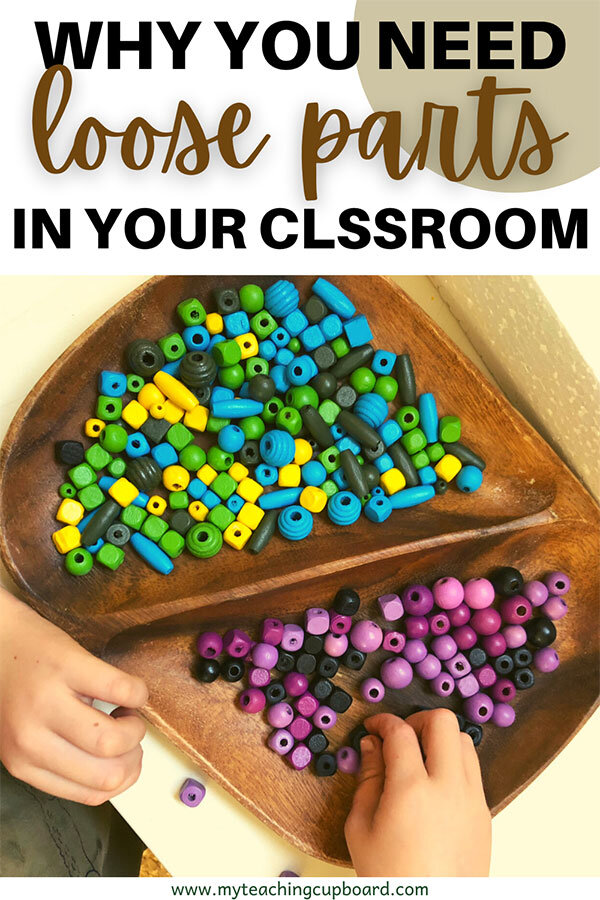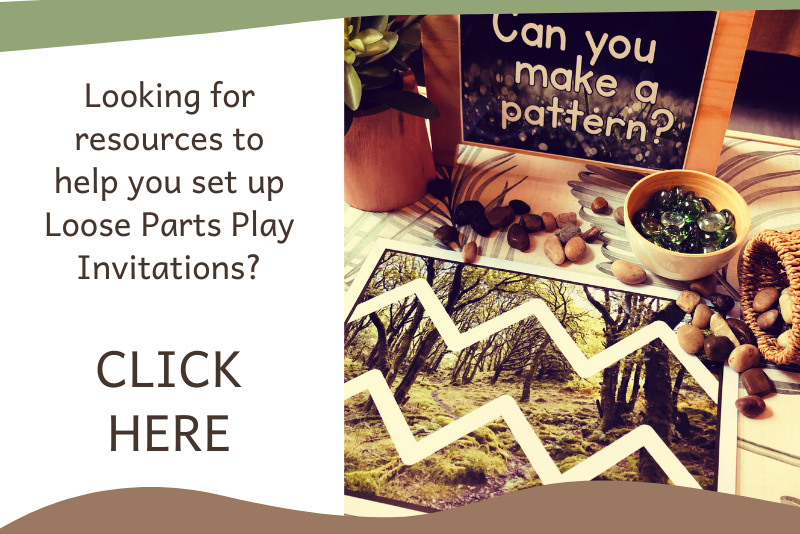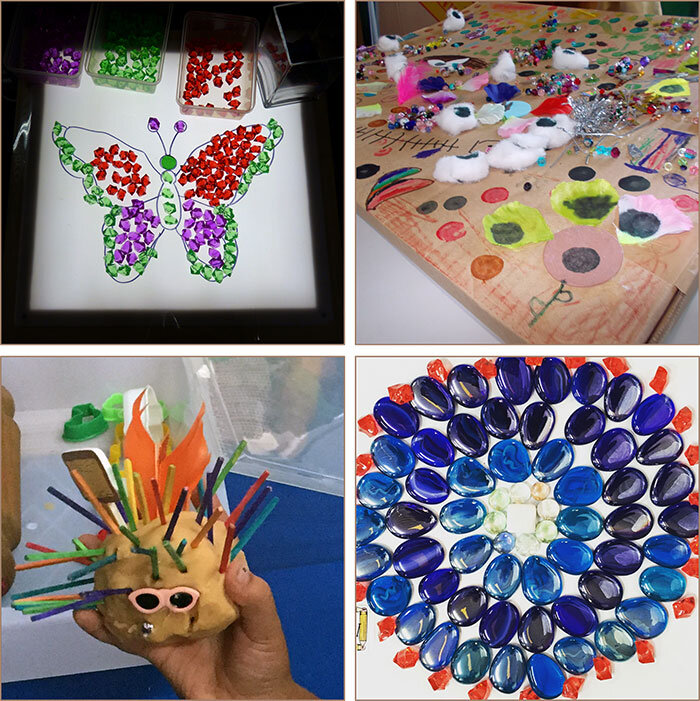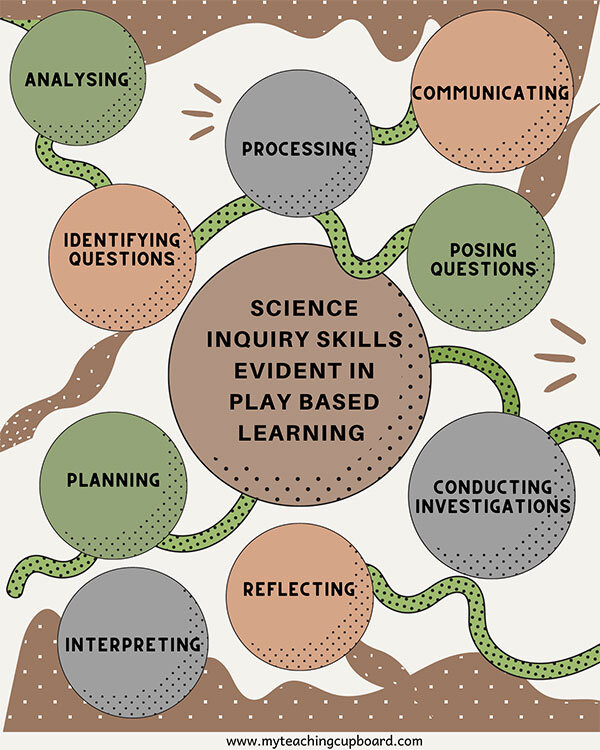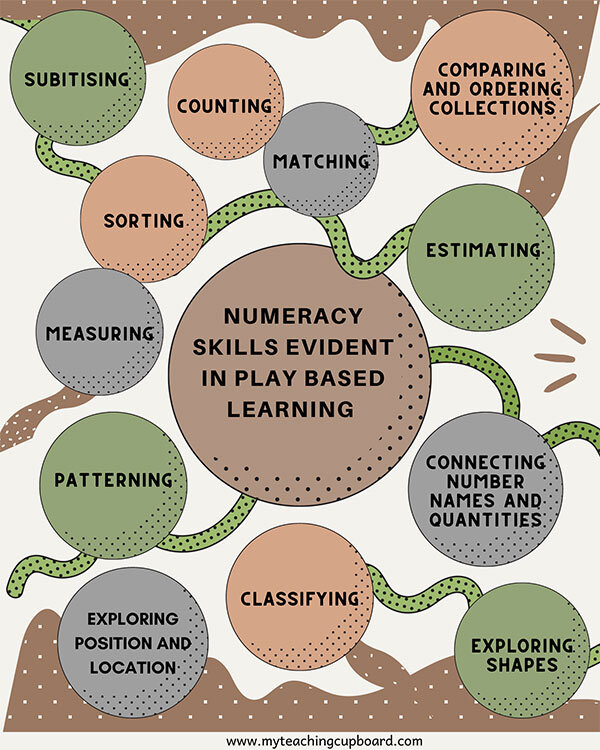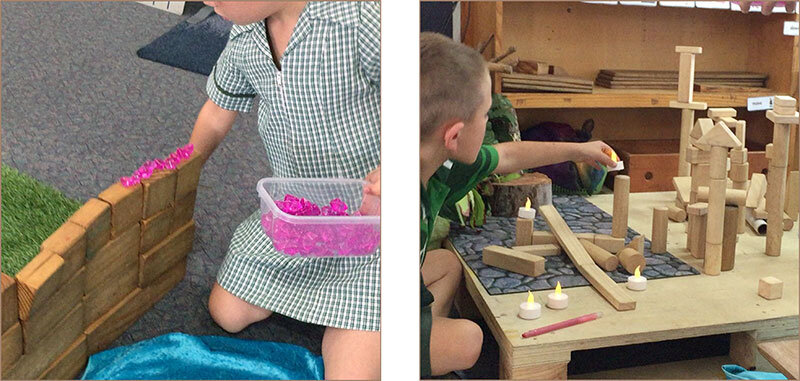Benefits of Loose Parts Play
Loose parts are a valuable resource in the early years learning environment. In this blog post you will discover what loose parts are and also find out the amazing benefits of using loose parts play in your learning setting.
Using loose parts in your classroom will have your students developing valuable skills across the whole curriculum – in literacy, numeracy, art, science, and more.
So many learning intentions are developed and practised by children through loose parts play. Just one loose parts activity alone can give your children the chance to cover many different curriculum learning intentions all from a wide range of curriculum subjects.
When children work and play with loose parts, they observe, enquire, investigate, construct, deconstruct and engage with others and the world around them. Giving the children in your classroom the opportunity to explore loose parts will allow them to apply and extend their learning.
What are loose parts?
In 1971, an architect named Simon Nicholson developed the theory of loose parts. His theory describes loose parts as any open-ended materials which encourage creativity and exploration in children. Children will naturally manipulate and use loose parts during investigative play experiences.
If you want to ensure maximum learning impact, the key is to provide loose parts which are open-ended. When you are collecting and offering loose parts, ask yourself, “Can these loose parts be used in a variety of ways and for numerous purposes?”
Because loose parts are open-ended, they will have endless possibilities unlike closed materials which can usually be used for only one purpose.
Loose parts come with no set rules or directions. They can be used by any age and developmental ability.
Loose parts can be natural or man-made. They can be large like tyres or small like beads.
Collections of loose parts can be completely random, or they can be compiled around specific themes. For example, items could be all the same colour, all come from the kitchen, all made from soft materials or all found outside.
Loose Parts Play Benefits Curriculum Learning Intentions
Loose parts play is an open-ended exploration where your children will engage in hands-on, concrete learning experiences. As your children explore the loose parts, learning will happen naturally. Loose parts play will help you to provide learning invitations which are more child centered and less adult directed.
Teachers still play a critical role in loose parts play. Your role is to
provide age-appropriate loose parts and provocations linked to your curriculum learning intentions
observe and collect information about your children as they interact with the loose parts
scaffold the children’s learning experiences to extend their learning and thinking.
As I have mentioned, so many skills are practised and developed by children in loose parts play. Here is a list of some of the main skills your children will be developing when you include loose parts play in your learning setting.
Creative Thinking Skills
Because loose parts are open ended, they can be used creatively in transient art activities. Transient art doesn’t just happen in the art area. You will see children creating beautiful artworks at block play or on the light table. In fact, transient art can be found in any area where you offer loose parts to explore.
Creative thinking skills are not just related to art or storytelling. Children are demonstrating creative thinking skills whenever they create solutions to problems and find new ways of doing things. The open-ended nature of loose parts allows children to experiment and creatively solve problems.
Higher Order Thinking Skills
As loose parts are open-ended materials, they naturally allow children to develop authentic higher order thinking skills. Your students engage in higher-order thinking when they are required ‘to explore, to question, to probe new areas, to seek clarity, to think critically and carefully, to consider different perspectives, [and] to organise their thinking’ (Tishman et al. in Venville, Adey, Larkin & Robertson, 2003).
According to Bloom’s taxonomy, there are 6 levels of learning: remember, understand, apply, analyse, evaluate, and create. The first 3 of these are lower level thinking and the last 3 are classified as higher order thinking.
Open-ended loose parts play is creative play and embodies the highest level of Bloom’s Taxonomy. Closed materials tend to stop the child at the level of understanding.
Loose parts play will give the children in your classroom the chance to evaluate their ideas and create something new and original.
In the early years of education, it is critically important to develop higher-order thinking skills, which enhance children’s mental abilities (Polette, 2012). Children use higher-order thinking skills when they engage in learning activities that require them to arrive at new meanings and understandings. When children do this, they transform their initial understandings. QCAA Queensland Curriculum and Assessment Authority
Scientific Skills
Science inquiry skills are evident any time you observe children learning through loose parts play. Science inquiry skills involve children identifying and posing questions; planning, conducting and reflecting on their investigations; processing, analysing and interpreting evidence; and communicating their findings.
Scientific skills are also concerned with evaluating claims, investigating ideas, solving problems, drawing valid conclusions and developing evidence-based arguments. The science inquiry skills children develop by playing with loose parts gives them the tools they need to achieve a deeper understanding of science concepts.
Math Skills
Just as many scientific skills are evident any time you observe children learning through loose parts play, so are many mathematical skills.
You will observe children developing and practising important numeracy skills and concepts like: connecting number names and quantities, patterning, counting, subitising, matching, sorting and classifying, comparing and ordering collections, estimating, measuring, exploring shapes and position and location.
As your children develop and practise their mathematical skills in loose parts play, they will gain a deeper understanding of numeracy. Loose parts are an essential component of authentic mathematical learning in the early years classroom.
Problem Solving Skills
As children play and manipulate the loose parts, they will be developing their problem solving skills. They will test and hypothesize, evaluate and re-test.
There will always be obstacles to overcome and problems to solve for children playing with loose parts. Young children enjoy experimenting with loose parts and will develop their problem-solving skills through trial and error.
Thinking abstractly is a problem solving skill that will grow over the first few years of schooling. It will allow children to be able to tackle everything from difficulties with social interactions to math problems.
Your students have learnt to solve problems from birth and are experienced problem solvers by the time they start school and enter your classroom.
In fact, children in preschool and kindergarten can solve problems through abstract-thinking and can often visualise a solution. It is important that they are given the opportunity to test out their solutions in a hands-on way though. Loose parts provide that perfect hands-on solution.
Concentration and Focus
As children explore loose parts, learning happens naturally. Loose parts play invites their learning explorations to become child centered as opposed to adult directed. Children will be engrossed in a way that it is hard to replicate through adult-led activities.
As children become engrossed in their explorations they will be learning to focus and concentrate on the task at hand. Loose parts play is so engaging because it is an activity which develops from the children’s own ideas and is therefore authentic and meaningful to the child.
Imaginative Play
A loose part can become anything.
Loose parts are the ideal tools for children developing creative and imaginative thinking skills. For example, through the eyes of a child, a stick can become a wand, a fishing line or a flag pole.
Loose parts can replace many single use toys and save you lots of money! Give your children the opportunity to play with loose parts and you will be giving them the opportunity to experiment and develop their own ideas, take on roles, build imaginary objects, and create fantasy worlds.
Social & Emotional Skills
Children will develop negotiation and communication skills as they interact with their peers and talk about their loose parts play experiences.
The development of social and emotional skills is evident whenever children work together. You will observe your children sharing and taking turns while they collaboratively play with their loose parts. You will also notice them listening and responding to each other’s ideas and experiences.
Your children will learn from each other and also learn how the social world works. Loose parts play encourages and invites children to share and work together.
Oral Language
When your children are exploring and playing with loose parts, you will observe them negotiating and communicating with each other. Vital oral language skills are practised and refined as they communicate with each other.
You will observe your children acting out stories as they imaginatively play with loose parts. There is a strong link between loose parts play and storytelling. Research also suggests there is a correlation between these early literacy storytelling skills and oral language development.
Children will learn new words and extend their vocabulary when they label and define the loose parts they are playing with. Loose parts play has a positive influence on the development of oral language in young children.
Motor Skills
Loose parts can be large or small. The larger loose parts will help children develop their gross motor skills while the smaller loose parts will help to develop their fine motor skills.
Smaller loose parts develop and strengthen children’s fine motor as they work their finger and hand muscles to grasp and pick up smaller loose parts. They will be using the small muscles in their fingers and hands to move and manipulate the loose parts to carefully place, to stack and build, to pick up, pinch and press. As they perform these tasks, they will also be developing their hand-eye coordination.
Large loose parts are often assigned to outdoor play or the playground. Whenever children use their bigger muscles to lift, pull, push and carry the larger loose parts around, their gross motor skills and their physical coordination will be developed and strengthened. The bigger and heavier the parts, the more movement and strength the children will need.
You will observe children constructing, manoeuvring and transporting a range of objects in loose parts play. They will be fiddling and balancing, sorting and positioning the loose parts. Loose parts play is the perfect formula for gross and fine motor development.
There are other benefits besides motor skill development when you add loose parts play to your outdoor learning environment:
In an effort to understand how loose parts in early learning environments benefit children’s play and development, through observations of preschool children in a rural outdoor natural environment, this study examined behaviours that children exhibited as they used loose parts. Children exhibited a range of positive social behaviours, complex verbal and nonverbal behaviours, and various types of risk taking in their play. The findings suggest that children do not explicitly exhibit stereotypical gender or age-exclusion behaviours while using the loose parts. The results would suggest that increasing children’s opportunities to use loose parts in an early years outdoor environment will support their various aspects of development in positive ways. (Children, Outdoor Play, and Loose Parts, Journal of Childhood Studies).
Independence
Child-led loose parts play fosters independence in young children. As the children take ownership and control of their loose parts play, they will set their own learning agenda and work to achieve personal and self-initiated goals.
Some educators worry that no true learning will happen in child-led play but when children are encouraged to take charge of their learning, they will work in their zone of proximal development, challenge themselves, take risks and grow in their confidence and independence.
Confidence and Self-esteem
There is no right or wrong way to play with loose parts. Children will work at their developmental level with no sense of failure. Because there is no right or wrong answer, no right or wrong strategy in loose parts play, children will not feel judged or evaluated. Confidence and self-esteem flourish in such a non-judgmental learning environment.
Loose parts play often becomes a group activity with children working together to reach a common goal. In this group learning experience, each child will feel a sense of achievement when they get to carry out a difficult task as part of a team.
Sustainability
Loose parts are often sourced by reusing and recycling materials otherwise destined for land fill. When you model these eco-friendly practises to children, you will be planting the seeds of sustainable living.
Sometimes loose parts are sourced directly from nature. These natural loose parts encourage children to appreciate the beauty of Mother Nature and develop pro-environmental behaviours.
The Benefits of Loose Parts as Learning Resources
Most classroom resources cost soooo much money! Loose parts however can be cheap and free. You can source your loose parts from nature. Think about pinecones, stones, shells, feathers, and sticks.
In fact, a lot of the loose parts collections in our classroom are collections children have initiated. A few feathers collected by a child at lunchtime out in the playground soon turned into a large bowl of loose parts feathers. Once we started collecting, the children brought in feathers found on their walks to school and on weekend adventures with their families.
Now we have a gorgeous set of loose parts which were not only free but because these feathers were lovingly collected by the children themselves, the children respect them and regularly use them.
The children have a sense of ownership over these loose parts. This all helps in building a classroom community.
Your children can also be involved in collecting loose parts from the recycling bin. Think about bottle caps, cardboard tubes, and yoghurt cups. As mentioned earlier, recycling is good for the environment and modelling this eco-friendly practice to children will help you to teach the benefits of sustainable living.
Collecting free and cheap loose parts will supply your classroom with multi-purpose resources resource which can be used over and over in your classroom rather than those traditional education supplies which have just one predictable use or outcome.
The Benefits of Loose Parts for Teachers
Play based teachers love setting up invitations for learning which are centered around loose parts because loose parts make it very easy to set up educational and engaging learning invitations. You can use them as a hook to spark interest in an activity because they are so inviting to children. Little hands love to explore and loose parts will spark curiosity and invite exploration.
You might be interested in these Nature themed Loose Parts Alphabet Mats. They can be used with loose parts like stones, counters or play dough to teach letter identification and letter formation in a sensory, hands-on way. These Reggio inspired, nature themed mats feature ALL Australian Curriculum fonts AND a standard elementary font.
YOU WILL RECEIVE:
A list of 60 loose parts ideas for your classroom.
Instructions to tile print the mats so you can change the print-out size.
2 Loose Parts learning prompts.
26 alphabet mats in your choice of Australian Font.
PERFECT FOR:
small group literacy rotations
independent work
literacy centers or investigation areas
These mats are linked to ACARA Content Descriptions:
Recognise and name all upper and lower case letters (graphemes) and know the most common sound that each letter represents (ACELA1440 )
Produce some lower case and upper case letters using learned letter formations (ACELY1653)
Loose parts can be added to any learning invitation and any investigation area. Loose parts will give your children numerous opportunities to practice and build on their developmental skills.
A few baskets of loose parts can act as a great starting point for an investigation area. For a quick and easy set up, just place a few containers of loose parts on a table or rug along with a couple of clipboards and a text. Then just stand back and observe.
Your observations of how the children use the loose parts and what they do with them will help you to better understand your children’s developmental levels. As your children interact with the loose parts, you can collect information which can then inform your future planning and reporting. This valuable information will help you to set up more complicated age-appropriate provocations which are aligned to your curriculum learning intentions.
The open-ended nature of loose parts allows you to differentiate the learning experiences you provide. We all need to cater to an array of developmental levels within any one class. As loose parts can be used in so many ways, they are ideal for developmentally appropriate learning experiences. With the same pile of stones, one child could make piles or towers, another could practice counting, and yet another could model multiplication problems by creating arrays.
‘When children interact with loose parts, they enter a world of “what if” that promotes the type of thinking that leads to problem solving and theoretical reasoning. Loose parts enhance children’s ability to think imaginatively and see solutions, and they bring a sense of adventure and excitement to children’s play.’ (Daly and Beloglovsky, 2015)
Using loose parts in your invitations for learning will foster child development in all developmental areas. As your children arrange and rearrange their loose parts, they will be creating their own pieces of work and the focus will be on the process rather than the product. Loose parts will enhance your learning environment and create stimulating and interactive spaces where your children can learn through play.
If you like this blog post on the benefits of including loose parts in your school day, please consider sharing it...
Just CLICK the sharing box below.👇

